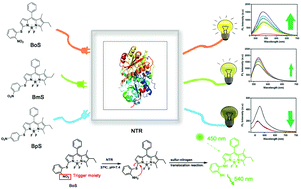Rational design of fluorescent probes for targeted in vivo nitroreductase visualization†
Abstract
Nitroreductase (NTR) has been recognized as a biomarker for identifying the hypoxic status of cancers. Therefore, it is of high scientific interest to design effective fluorescent probes for tracking NTR activity. However, studies on elucidation of the structure−performance relationship of fluorescent probes and those providing valuable insight into optimized probe design have rarely been reported. Three BODIPY based fluorescent probes were made by conjugation of para-, ortho-, and meta-nitrobenzene to the BODIPY core via a thiolether bond, respectively. Our study revealed that the linkage and nitro substituent position significantly influence the capability of nitroreductase detection.



 Please wait while we load your content...
Please wait while we load your content...